The Landscape of Housing
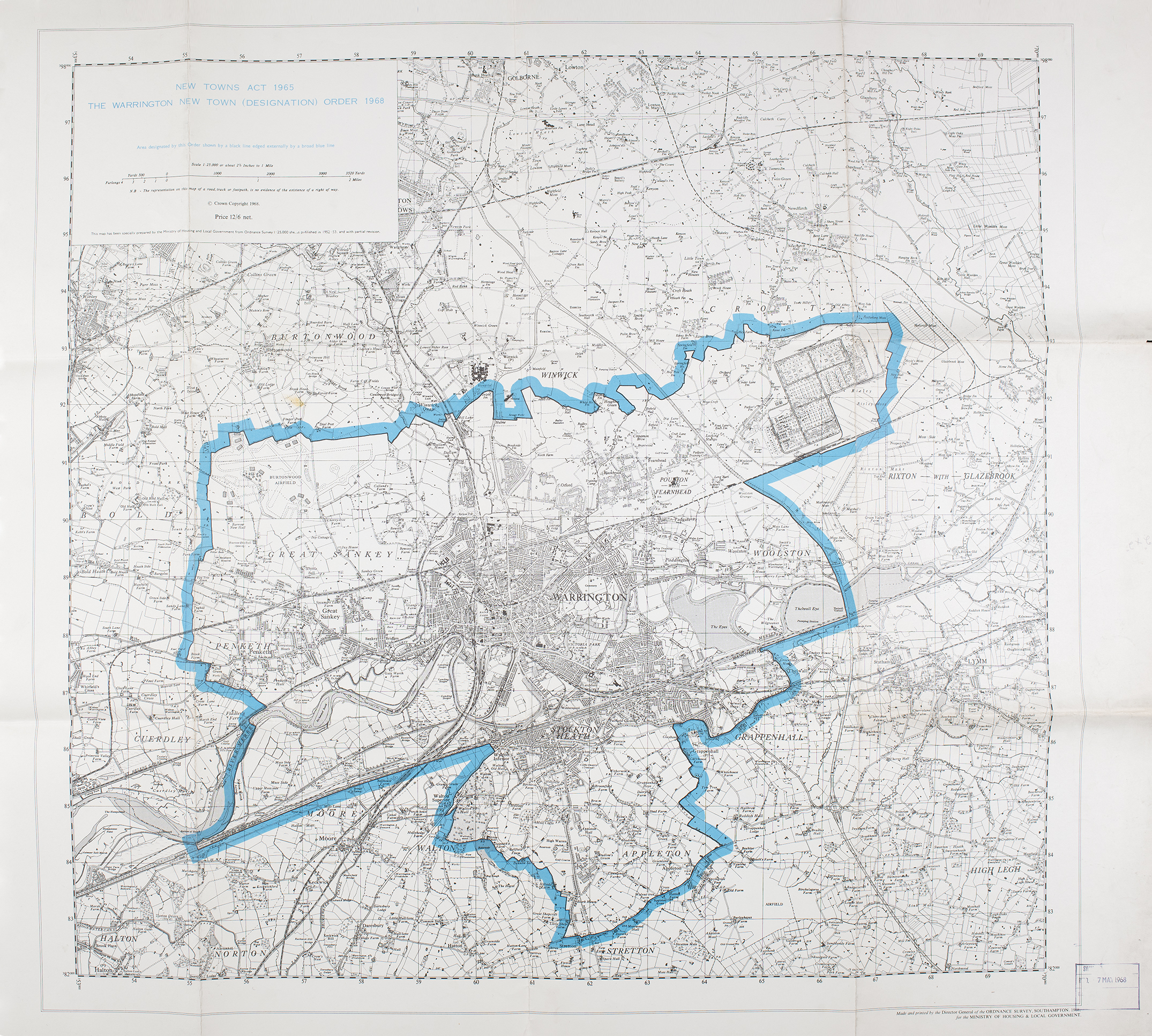
In 2022 The FOLAR symposium held at The MERL explored how Landscape Architecture worked in alliance with the design and planning of post-war housing.
This exhibition explores these themes by highlighting some of the key Landscape Architects of this time, using documents and drawings from the Landscape Institute collections held in our Special Collections.

New Towns
New town developments were created after a series of acts by Parliament. Beginning in 1946, they were a post war initiative and designed in three waves.
This Map prepared by the Ministry of Housing and local government depicts the new town of Warrington; Warrington was elected a new town in the third wave (1968).
The renowned Landscape Architect Dame Sylvia Crowe (1901-1997) who worked on several new towns, was involved in the masterplan for Warrington.
Crowe believed that these new towns should be sensitive to the existing landscape, that agriculture should be conserved, and that safe and pleasant access should be created.
At Warrington she created mass planting so that the town would sit naturally in the land. You can Read more about her methods in this: Memorandum by The Garden History Society
.
© This image Contains public sector information licensed under the Open Government Licence v3.0.
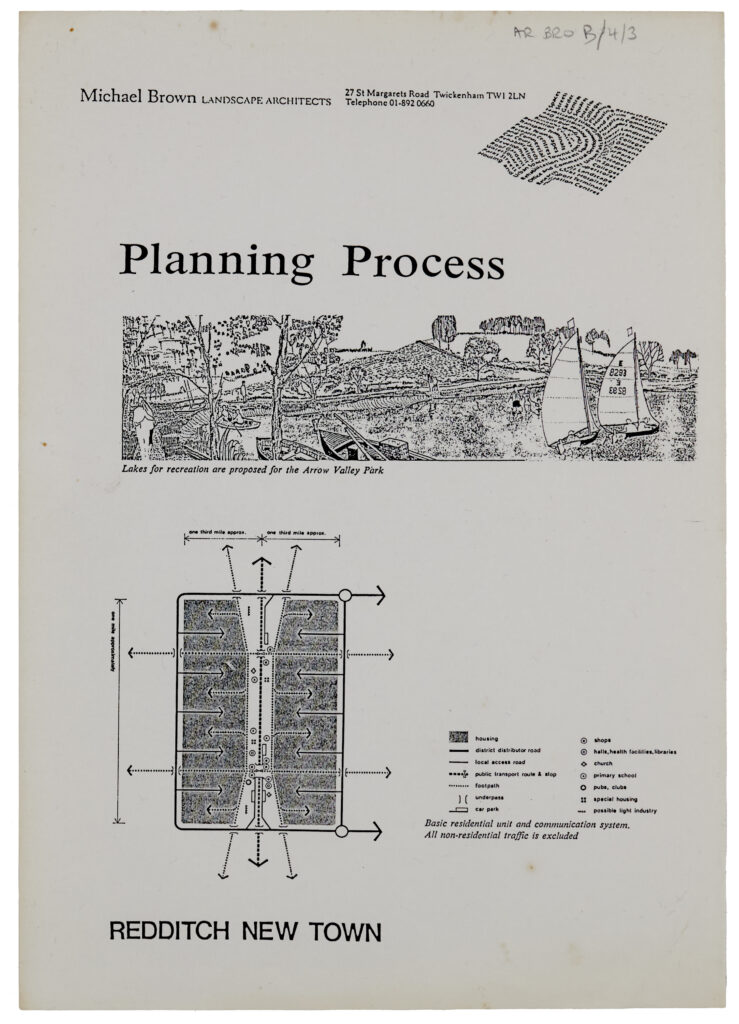
Planning a New Town
Redditch was designated a New Town in 1964, aimed at easing overcrowding from the West Midlands. It is one of the first New Towns to have emphasis on public transport.
This exhibit is shared from our Michael Brown (1923-1996) collection and shows an overview of the planning process of Redditch as a New Town; of which Brown was responsible for developing the Master Plan.
Here Brown proposes lakes for recreation and excludes non-residential traffic.
Image © shared with permission from Michael Brown’s family estate

SPAN Developments
SPAN Development Ltd was a company set up by eminent Architect Eric Lyons and his business partner Geoffrey Townsend. In SPAN’s successful period it created over 2000 homes in London, Gloucestershire and home counties.
In the 50s and 60s, Lyons employed Landscape Architects Preben Jakobsen and Michael Brown to design the landscapes for these developments.
Pictured is an illustration of a New SPAN development in Cheltenham (created in the 1960s), taken from a leaflet found in our Preben Jakobsen Collections.
Image © Dennis Bailey (reproduced with family estate permission)
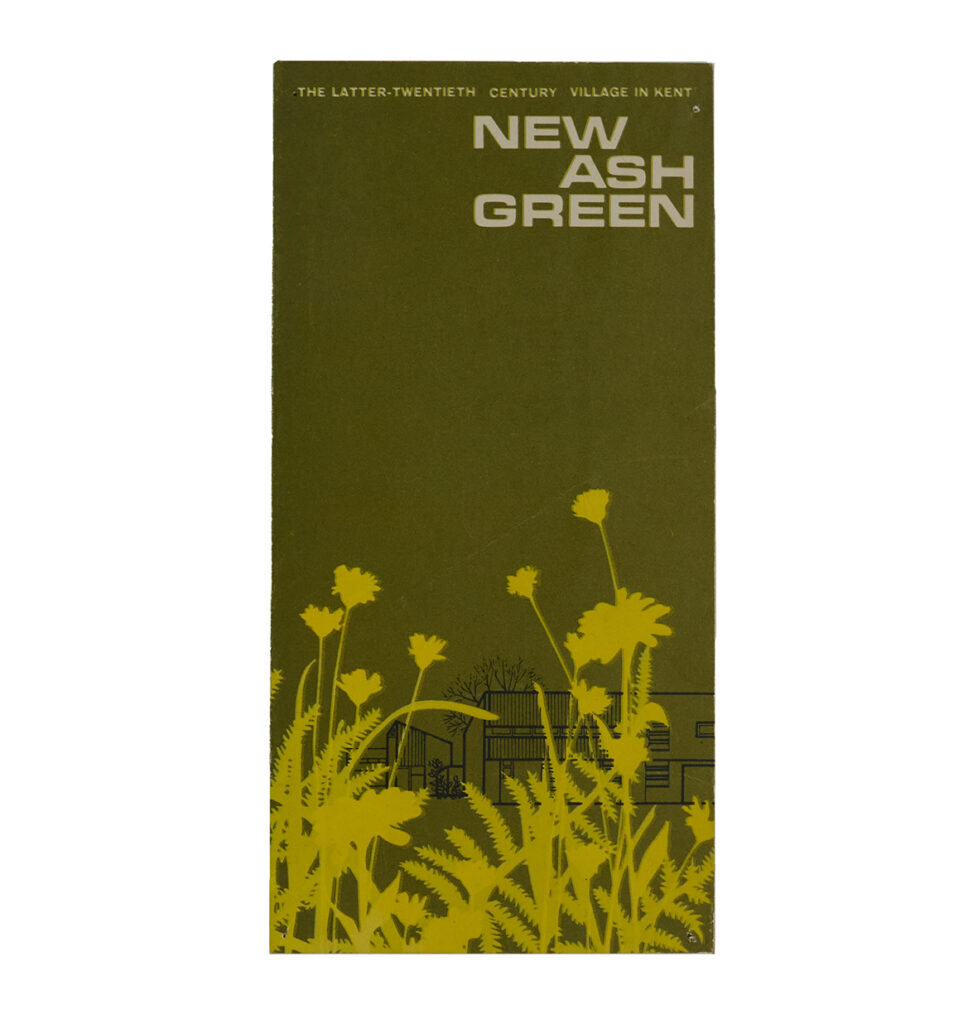
New Ash Green
Dating from 1966 the New Ash Green project, is an entire village conceived and created by SPAN. The preservation of the countryside was a major concern of the SPAN directors.
In the 2022 FOLAR symposium, researcher Karen Fitzsimon presents on New Ash Green demonstrating why these SPAN developments have survived whilst other developments in the same period have not.
.
“…It has been identified by residents that the biodiversity of the landscape & nature at New Ash Green have an important role to play in combating the climate emergency…they are very keen to conserve & encourage it.”
– Fitzimon (2022)
New Ash Green is an example of community living, which SPAN claimed to have more experience in creating than anybody else.
Those who continue to live in New Ash Green are part of a residents society, and can also serve on a committee. Should this village become a model for living today?
Find out more about our collections featuring SPAN below.
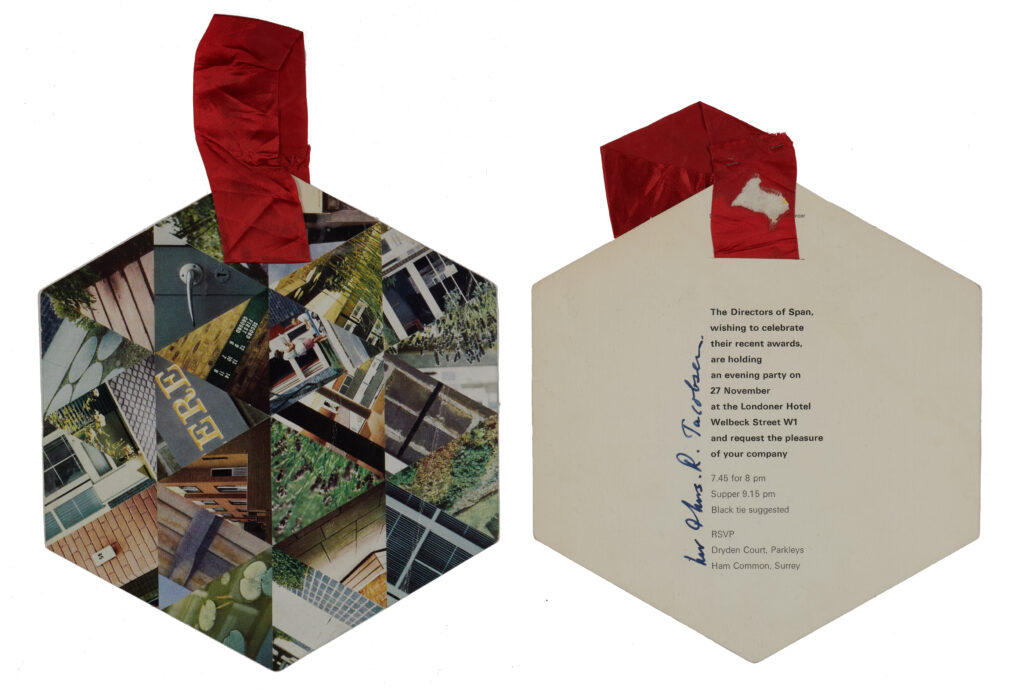
An Invitation from the directors of SPAN
Preben Jakobsen joined Eric Lyons practice in 1961. During its tenure SPAN won several awards.
This item from our Preben Jakobsen collection shows an invitation to Mr and Mrs Jakobsen to attend a black tie event, in order to celebrate SPAN’s achievements.
It features cropped photographs from SPAN developments; including images of planting and more natural elements…
Explore our Preben Jakobsen collection below.
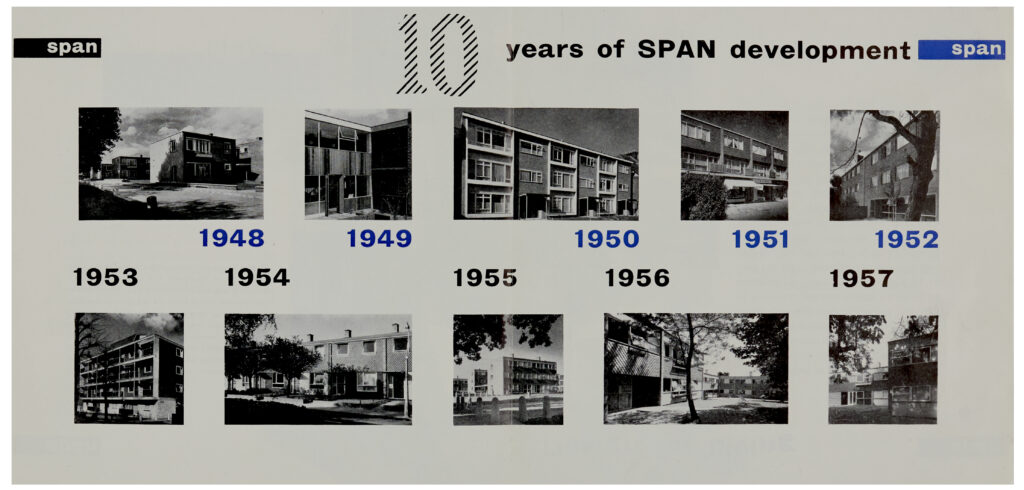
A Timeline of SPAN
Over the years, SPAN consisted of several companies undertaking residential investments and developments.
Up to the end of the 1960s SPAN was involved in approximately 73 schemes, comprising of 2,134 dwellings.
This document from our collections illustrates a 10 year timeline from SPAN’s history. The directors at this time: Townsend, Cushman and Bilsby, took great care to include landscape architecture at the heart of all of their planning.
They believed that efforts should be made to preserve the natural elements of a site, including pre-existing trees. They also assured that grounds were fully planted, predicting that in 50 years time they would remain pleasant places to live… in 2023 the existing developments are a testament to this.
.
Explore more about SPAN flats through our Preben Jakobsen collection below.

A Handbook on Urban Landscape
Clifford Ronald Vivian Tandy (1919-1981), a pioneering landscape architect, had a varied career working in private practice and for the local government. Tandy also worked to improve the environment for army bases in Britain and around the World.
In 1971 Tandy edited the ‘Handbook on Urban Landscape’ created as a desk guide to support and to serve his fellow urban designers and its students. The image shares an extract from a typed manuscript found in our Michael Brown Collections. [reference: AR BRO SP/4] The handbook has been reprinted many times and was originally a series in the Architect’s Journal.
Shown here the digitised section discusses current trends of the post war period, explaining relevant government legislation.
The handbook aimed to review trends in landscape design for urban situations and included: housing, parks, open spaces, play spaces and recreation spaces. It involved several authors, all of whom were landscape architects, including Michael Brown.
You can explore some of Tandy’s photographic collection below.

Housing: Detailed Design
The Landscape Architect Michael Brown produced detailed information sheets for the Handbook on Urban Landscape a guide edited by Landscape Architect Clifford Tandy, detailed in the previous exhibit panel.
In this information sheet Brown discusses external housing examples; demonstrating how planting contributes to the personality and necessary functions of a design by playing with textures, enforcing privacy, and reducing the visual effect of parked cars.
Image © shared with permission from Michael Brown’s family estate

Landscape Assessment
This panel further demonstrates Landscape Architect Michael Brown’s attitude to planting, showing how Brown assessed landscapes, again in an information sheet format.
This time Brown focuses on Georgian streets and squares. It is another of his contributions featured in the Architect’s Journal as part of the Handbook on Urban Landscape.
Brown dictates his professional views on tree planting in the streets:
.
“There is a serious misconception about tree planting close to buildings – they are often erroneously regarded as dangerous, undesirable, or unnatural, but many splendid streets depend on them. The growth shape adapts to suit the condition of habitat…”
You can also see an illustrated key showing how Brown assessed this type of landscape.
Image © shared with permission from Michael Brown’s family estate
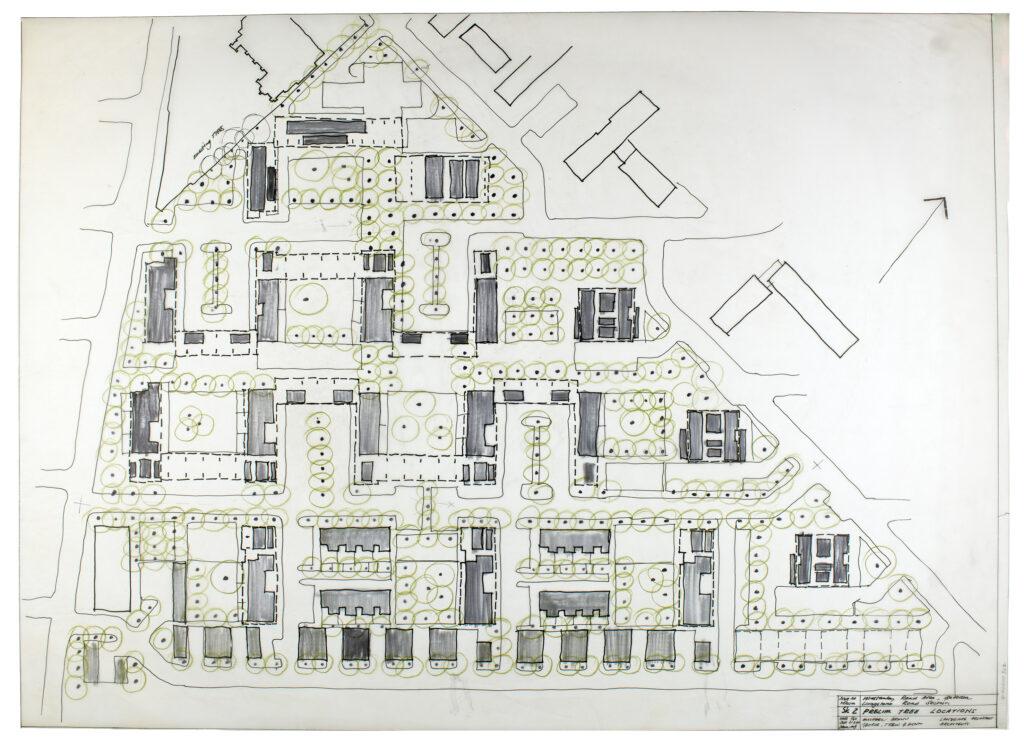
Winstanley Estate: Battersea
Prolific and award-winning Landscape Architect Michael Brown specialised in landscapes designed for housing.
This hand-drawn plan depicts the Winstanley road and Livingstone road section of the Winstanley estate, showing preliminary tree locations, which were planted to alleviate the use of brick.
The Winstanley estate was refurbished in the 1980’s, but is now undergoing re-development along with the York Road estate as part of a large regeneration project, Read a little bit more about the Winstanley Road here.
Image © shared with permission from Michael Brown’s family estate
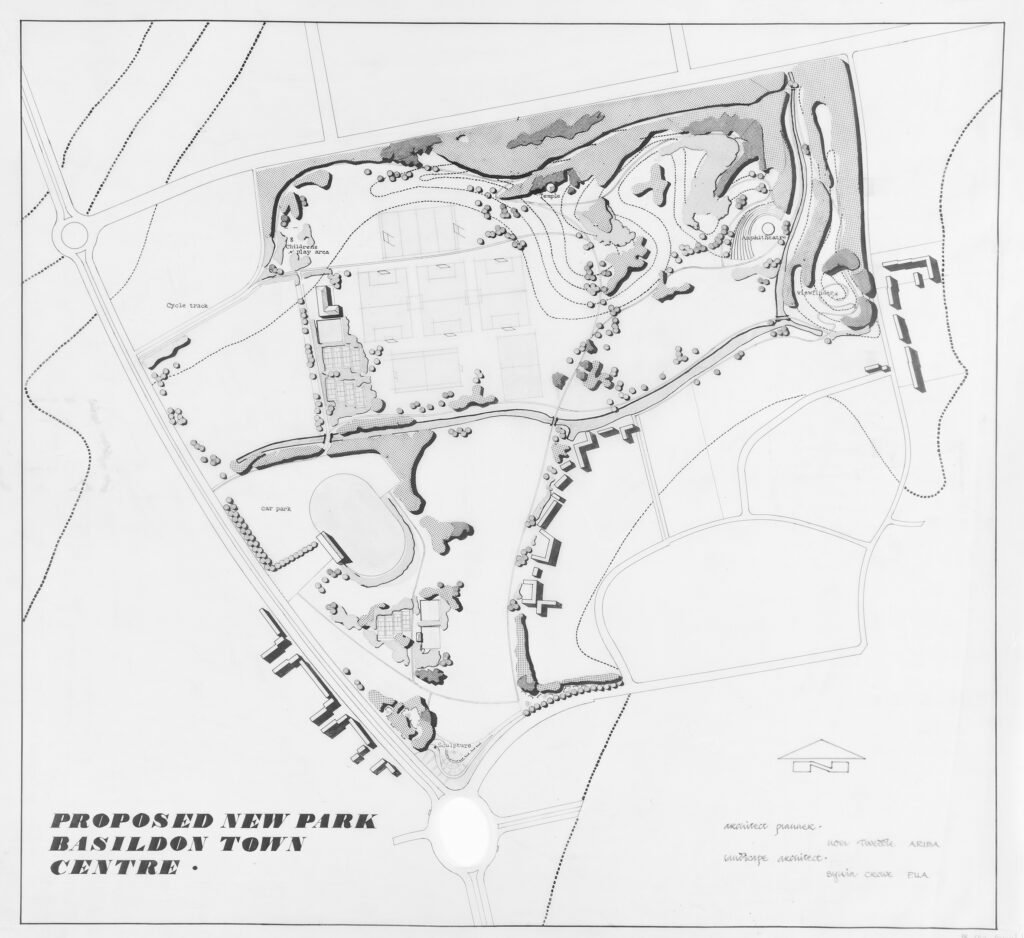
Basildon
Dame Sylvia Crowe, Landscape Architect, set up her own private practice in 1945, working on Basildon New Town in the County of Essex until 1962.
Basildon was designated a New Town in 1949, and was a part of the earliest waves of New Towns (discussed in the first exhibition panel) it was created to alleviate the shortage of housing resulting after World War II.
This drawing from our Sylvia Crowe collection shows a proposed new park for Basildon town centre, listing Architect Planner Noel Tweddle and Crowe as the Landscape Architect.
Sylvia Crowe became the president of the Institute of Landscape Architects from 1957 to 1959.
Explore the catalogue below.
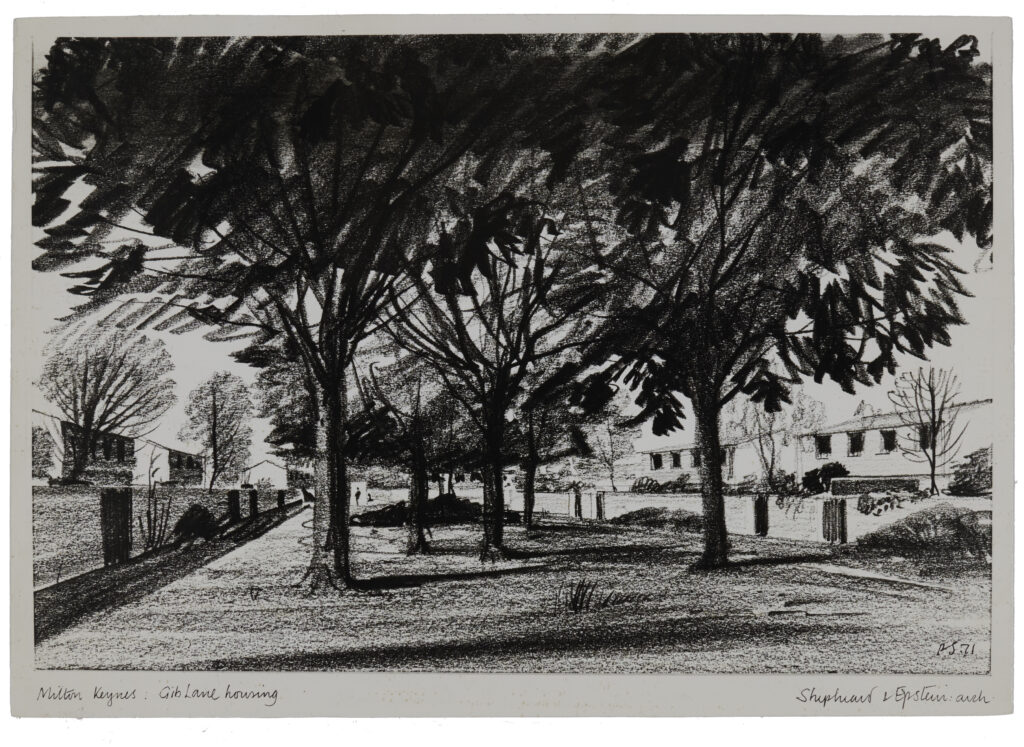
Milton Keynes: Gib Lane Housing
Sir Peter Faulkner Shepheard (1913-2002) was an Architect and a Landscape Architect.
During his time working for the Ministry of Town and Country Planning, Shepheard also worked on early prototypes of New Towns. This was part of the Greater London Plan for post-war regeneration and growth in the capital.
In the 1960s – as part of the third wave actioned by the UK government – Milton Keynes (in the County of Buckinghamshire) was designated a New Town in 1967. Created to support one of the largest populations of any New Town.
This drawing featured in our Peter Shepheard collection, illustrates planting alongside housing on Gib Lane.
You can explore more of our Shepheard collection below.